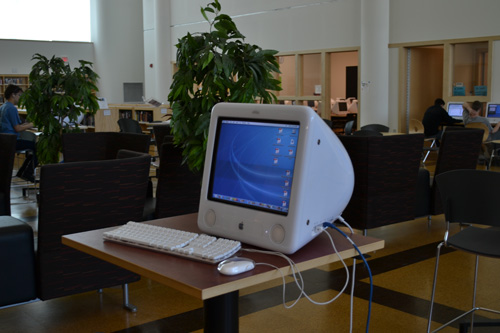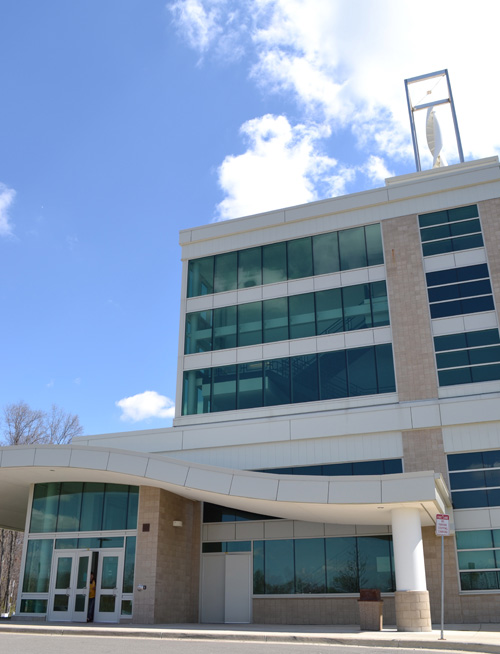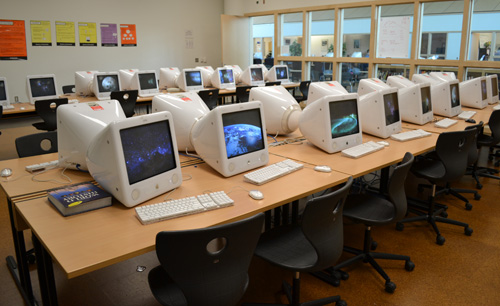
By Tara Cavanaugh
Skyline High School still looks as shiny and new as the day it opened four years ago. Outside, modern steel beams crisscross over airy windows that stretch up its four floors. Inside, tall ceilings and natural light show off a pristine interior unblemished by time.
So why would Skyline be allocated any dollars from the Technology Bond if it passes?
The answer is simple, says John VanRiper, director of information technology for the Ann Arbor Public Schools. As the students transitioned into the new high school, so did old equipment from other schools.
“So the technology itself is, with few exceptions, as old as what we have in the rest of the district,” he says.

The library computer labs are full of eMacs that are five to six years old. The laptop carts are three years old or more. Two computer labs were supplied with new computers when the school opened, but now those are four years old.
According to district estimates, Skyline would receive $342,000 for new computers to replace the old ones if the bond passed. Only two more schools would receive more money for computers: Huron High School would get $390,100 and Pioneer High School would get $449,000.
Like the other schools, Skyline also would receive more than new computers.
“The wireless infrastructure at Skyline would be be upgraded to handle the load too, just as it would every place else,” VanRiper said. “That building for the most part has building wide coverage…But they’re not capable of handling the load. That’s the issue we’re having now–and throughout the district.”
By upgrading “wireless infrastructure,” VanRiper means replacing the cables and servers that deliver wireless internet. Those will be updated, and so will the storage rooms that hold that equipment.
But because Skyline is such a new building, cabling and renovations won’t cost nearly as much. If the tech bond passes, the district would spend $23,900 on Skyline to update cabling. Only one other school would cost less in cabling work: the much smaller Preschool and Family Center.
And Skyline’s estimated cost for mechanical and electrical renovations is around $32,000, which is much less than an old building like Pioneer, which would need nearly $122,000 for the work.
“(Skyline) is a brand new building. Gorgeous building,” VanRiper says. “But it has a significant amount of aging technology in place that was transferred from other high schools and the wireless infrastructure will be upgraded too, just like every other school.”

Related stories
- INFOGRAPHIC: The Tech Bond by the numbers
- INFOGRAPHIC: AAPS Educators talk technology
- All district computers now out of warranty
- District hopes to expand wireless access
- Old computers lead to workarounds, wait time during reading intervention
- Spanish students use web, tech resources to work on speaking skills
- Elementary teacher upgrades writing lessons
- Before technology upgrades, old buildings need renovations

What will happen to the old computers once they are replaced? I would vote that AAPS should sell them to the family’s of the district so they can make more money in return. Some of the laptops could be sold at a reasonable price and are in great shape and condition.
Hi Seth,
I took your question to John VanRiper, the director of instructional technology for the district. He said 95 percent of computers that are eventually gotten rid of are “pretty much dead.” He also pointed out that if the district wanted to resell some computers, they would have to be stripped of all software and programs because they’re only licensed for school use, not personal use. Stripping old computers of that software is a long and difficult process.
Many of the school computers that are deemed too costly to repair are stripped for parts, kind of like an old car. This helps the district make repairs. For example: If a laptop is deemed no longer usable but still has a good screen, the screen will be saved. This means that a lot of the old computers hanging out in the warehouse aren’t even complete!
So while reselling computers seems like a great idea, the district uses the computers until they are essentially lifeless. Even if the old computers have some functions left, they’d have to be stripped of software before they could be used by someone else.
Thanks for reading the AAPS News! I hope this answers your question.
Best,
Tara Cavanaugh,
AAPS News Editor
Are we looking to source any of these supplies locally? As a local buisness owner (not in the tech field) and A2 tax payer, I would love to see as much of what we spend on local labor and local purchases. I understand alot of this is done as a bid process, but local infusion of money to our buisnesses is what keeps the circle of funds flowing back to the schools. Thanks.